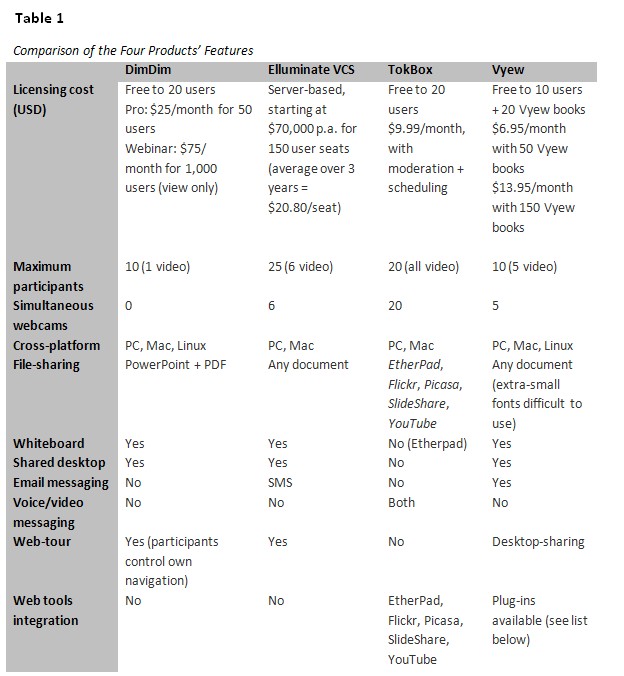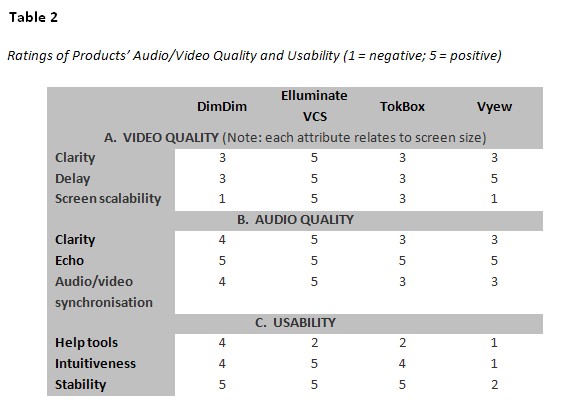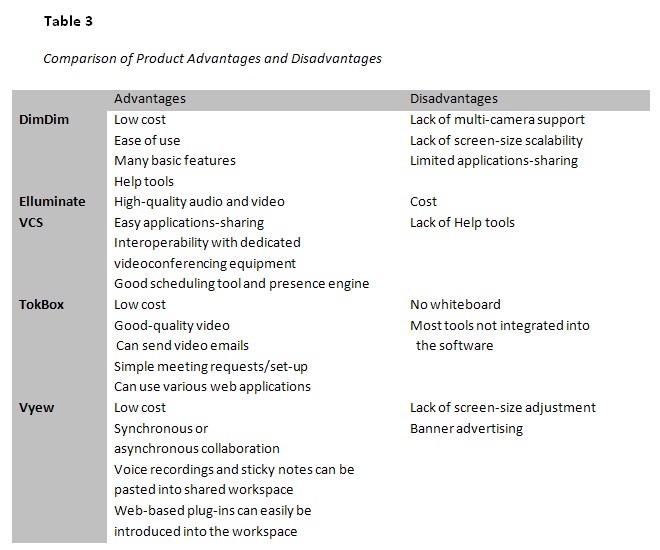[Print Version]
February – 2011
72. Online Videoconferencing Products: Update
Douglas Burton and Tim Kitchen
Athabasca University, Canada
Abstract
Software allowing real-time online video connectivity is rapidly evolving. The ability to connect students, staff, and guest speakers instantaneously carries great benefits for the online distance education classroom. This evaluation report compares four software applications at opposite ends of the cost spectrum: DimDim, Elluminate VCS, TokBox, and Vyew. Their benefits and shortcomings are contrasted, and efficient educational scenarios for them are suggested.
Introduction
Since the original review of videoconferencing software in this evaluation series (Craven, Keppy, & Baggaley, 2002), tools for online conferencing have evolved dramatically. Many of the ten products compared on the previous occasion no longer exist. New ones have taken their place and have been reviewed under integrated software headings in the series, including a new product, Elluminate VCS, which focuses on high-quality video and platform interoperability with dedicated videoconferencing equipment. This updated product is compared in the current report with three freeware applications: DimDim, TokBox, and Vyew.
Until recently, many factors kept real-time desktop videoconferencing from being a practical solution for connecting distance learners. The most obvious of these were the lack of adequate bandwidth availability and the high cost of the tools and equipment they require. With high-speed bandwidth increasing in many regions of the world, however, and with reduced costs of built-in and external computer webcams and microphones, this means of online collaboration is becoming more prevalent. According to Schenker (2008), “the worldwide videoconferencing systems and services market, which reached $1.6 billion in 2007, is expected to grow to $4.2 billion by 2012.” As to the educational and training sector of this market, Wainhouse Research has reported that it “reached about $680 million in 2009, and is projected to grow to more than $1 billion by the end of 2014” (Tierney, 2010). The current report focuses on four different videoconferencing software products, highlighting the strengths and weaknesses of each and ways for educators to use them effectively.
Product Trials
This report does not present a strict apples-to-applescomparison, but instead a store-bought- apples-to-free-roadside-apples comparison. By deliberate choice, a fully featured commercial application is compared with three freewareconferencing applications. The rationale for this selection is that, in the open- and distance-learning field, budget and a vast range of educational objectives need to be considered. The software applications selected for comparison here are DimDim, ElluminateVCS, TokBox, and Vyew. These applications all have commercial versions and the ability to share webcam video, but they differ greatly in other respects. Elluminate VCS is the only product of the four that does not also have a freeware version. This study compares the commercial Elluminate VCS with the free versions of TokBox, DimDim, and Vyew.
It must be stressed that the current comparison may have been affected by fluctuations in product stability due to Internet traffic and bandwidth capacity, computer processing and host server speed, microphone sensitivity, network accessibility, and operating systems. The author-reviewers used a consistent technical platform in relation to each of these variables for reviewing all four products. The products were reviewed in April, 2010 in terms of the following features:
- maximum participants – number of participants who can join the conference from individual computers;
- simultaneous webcams – number of cameras visible on the screen at any one time;
- cross-platform – ability to use the software on multiple operating systems (as stated by software manufacturer, though not actually tested by the reviewers);
- file-sharing – ease with which participants can exchange computer files (1 = hard to use, 3 = moderate ease of use, and 5 = data files and video clips easily shared);
- whiteboard – shared writing and drawing feature (1 = hard to use, 3 = moderate ease of use, and 5 = very easy to use);
- shared desktop – ability to share an individual’s screen image (1 = hard to use, 3 = moderate ease of use, and 5 = very easy to use);
- email messaging – ability to send and receive email within the product (1 = hard to use, 3 = moderate ease of use, and 5 = very easy to use);
- voice/video messaging – ability to send and receive voice messages (1 = hard to use, 3 = moderate ease of use, and 5 = very easy to use).
- Web-tour – ability to lead other participants on a co-surfing or shared browsing experience by taking over their computer displays.
- Web tools integration – ability to work with other communication applications; some products have a built-in feature for sending email, instant text messages, attachment files, and voicemail, but fulfill these functions solely within their own environment; other products can be used in conjunction with external email applications on a convenient, integrated basis (1 = hard to use, 3 = moderate ease of use, and 5 = very easy to use).
These features of the four conferencing products are compared in Table 1.

The following product features were also rated by the reviewers on the basis of their April, 2010 trials:
- video clarity – visual precision (1 = barely visible, 2 = obvious pixilation, 3 = minor pixilation, 4 = clear with no obvious pixilation, 5 = DVD quality);
- video delay – lag and unintended pauses in the visual feed, resulting in jerky images (1 = major lag, 2+ secs., 2 = lag, 1-2 secs., 3 = lag < 1 sec., 4 = barely perceptible delay, and 5 = real-time motion, no discernable lag);
- screen scalability – capacity to increase or decrease screen size (1 = no adjustment possible, 2 = some adjustment possible with decrease in clarity, 3 = adjustment possible to small, medium, or full screen with decrease in clarity, 4 = some adjustment possible with no decrease in clarity, and 5 = adjustment possible to small, medium, or full screen with no decrease in clarity);
- audio clarity – clearness of the sound (e.g., the ability to hear a voice without background noise, white noise, crackling, interference from nearby electronic devices, etc.) (1 = barely audible, 3 = reasonably clear, and 5 = studio-quality recording);
- Echo – ringing and feedback, requiring the use of external headset and microphone (1 = major, 3 = moderate, and 5 = non-existent;
- audio/video synchronization – delay and lag between sound and visual (1 = major, 3 = minor, and 5 = real-time synchronisation);
- help tools – built-in or downloadable user manuals, tutorials, FAQs, search, help by email/ fax/telephone/webinars, etc. (1 = minimal help available, 3 = moderate amount of relatively clear help, and 5 = numerous clear and easy-to-use help tools);
- intuitiveness – user-friendliness compared with more familiar media (telephone, text chat, etc.); some products try to replicate familiar web-page or software navigation styles, others augment styles of use to which their subscribers have become accustomed, and still others create an original environment that requires new learning (1 = hard to use, not intuitive, 3 = moderate ease of use, and 5 = very easy to use).
- stability – availability of a constant standard of operation for the software (e.g., no freezing or crashing) (1 = unstable, 3 = minimal freezing or crashing, and 5 = uninterrupted use).
The reviewers’ ratings of these product features are given in Table 2.

Summary of Product Evaluations
Overall, the four products gave adequate-to-good quality of service, summarised as follows:
- DimDim is a free, open source web meeting platform with surprisingly rich features for up to 20 simultaneous attendees and a fee-for-service version allowing a larger number. The product’s extensive list of basic services includes live screen-sharing, synchronised web browsing, whiteboard, and document-sharing. DimDim’s help tools are without equal and include dial-in phone support. DimDim requires Flash installation and is supported on the Internet Explorer and Firefox browsers. Its lack of screen-size scalability and its support for only one webcam are major limitations. The product has limited application-sharing with the only shareable document types being PowerPoint and PDF formats. Microsoft Word is not supported, and there are limited desktop-sharing features.
- Elluminate VCS is a commercial product, which received the highest overall ratings in this review in all features except help tools. Elluminate VCS stands out from the other three products in relation to its high-quality video and audio. It is also the only product that features H323 interoperability, i.e., the ability to connect to dedicated videoconferencing hardware end-points. This is a highly desirable feature for institutions with sites that need to connect with remote videoconferencing equipment. Elluminate VCS has an attractive and simple navigation interface, powerful sharing and collaboration tools, a “presence engine” that makes it easy to initiate spontaneous connections, and an effective meetings scheduling tool. Surprisingly, the product’s help tools are limited, lacking the benefit of online tutorials, webinars, and a searchable database. It is to be hoped that this issue will be rectified in the next software release as the features for it are built into the user interface shell. Elluminate VCS is an institutional server-based solution and cannot be installed on individual computers by a lone, innovative teacher. This feature permits greater server-based control and increased security but requires substantial up-front expenditure. The license cost for a minimum of 150 users over 3 years averages $20.80 per seat/month and represents a long-term commitment. The $70,000 server, installation, and set-up costs for the initial year, plus an additional 17% service fee for each subsequent year, may put the product beyond the means of small institutions but make it a reasonable investment for medium-to-large institutions.
- TokBox is a very useful tool with a number of unique features; the best feature is the ease with which it connects participants. The product is web-based and requires no download. Equally impressive is the fact that invitees do not need an account to use the product, which allows new participants to be invited into a session spontaneously. Another distinctive feature is that participants can email, video-mail, and instant message each other and can initiate a session by posting an invitation on a social networking site such as Twitter, Facebook, or MySpace. A single session can have up to 20 people sharing video, collaborating using an Ethernet Pad, and uploading HTML, Word, or RTF files. The use of EtherPad involves a “time slider” by which the collaboration can be reviewed and saved to various file formats. In addition, content can be shared through Flickr, Picasa, SlideShare, and YouTube. Audio and video quality is very good for a free tool, and easy adjustments of video size and switching between applications are possible.
- Vyew is also a completely browser-based conferencing platform with no downloads or added services required. The developer claims that it is compatible with 95% of all browsers. Free for up to 10 participants, Vyew offers a wide range of features, including file-sharing, whiteboard, desktop-sharing, screen-capture, shared mouse cursors, and useful plug-ins, including MP3, Flash/YouTube players, and polling. Meeting setup is the most difficult of the features reviewed. With no integrated email messaging, inviting participants to a meeting requires contact addresses to be entered manually. The free Vyew version displays advertising banners.
An overall summary of the products’ advantages and disadvantages is given in Table 3.

Conclusion
As open and distance education evolve, teachers, students, and administrators continue to seek effective ways to connect and collaborate. This review has considered several current products, based on desired outcomes, kinds of operational settings, and budget, especially important in times of economic hardship.No one conferencing tool is likely to satisfy the needs of all institutions and participants. Having reviewed several software products beyond the ones discussed here, the current reviewing team is encouraged to see the many new ways that participants can communicate and collaborate from wherever they may be in the world.
DimDim’s many basic features make it a solid all-round product. It is a useful tool if one does not need multiple and flexible video as part of a collaboration and if the product needs to be free. DimDim’s help tools and ease of use make it a good choice, but its lack of multi-camera support, lack of screen scalability, and limited application-sharing are major drawbacks.
Elluminate VCS is a good product for an organisation that is looking for an institution-based solution with a minimum of 150 participants, and for which cost is not the primary factor but for which connecting with existing videoconferencing equipment is paramount. The product is useful for formal presentations, guest speakers, and small meetings where high-quality audio and video are required.
Vyew’s lack of screen-size adjustment and banner advertisements can be frustrating; otherwise, it is a fully featured product with solid collaboration features and is a strong candidate for any course requiring group work. Vyew would be an especially good choice for asynchronous collaboration across multiple time zones.
TokBox is the most fully featured tool of the freeware applications tested here. Its most unique feature is the ability to send video email. It gives good quality and scalable video for up to 20 participants at once. The product is appropriate for collaborative projects and for sending students personalised weekly messages and feedback.
It is hoped that these product reviews provide a starting point for comparing other products currently available to enhance the online learning experience.
References
Craven, P., Keppy, B., & Baggaley, J. (2002). Online videoconferencing products. International Review of Open & Distance Learning, 3(2). Retrieved from http://www.irrodl.org/index.php/irrodl/article/view/88/167.
DimDim. (2010). Real-time collaboration made real easy. Retrieved from http://www.dimdim.com/.
Elluminate VCS. (2010). eLearning and collaboration Solutions. Retrieved from http://www.elluminate.com/.
Schenker, J. L. (2008). Economic woes boost videoconferencing. Bloomberg Businessweek, (August 5). Retrieved from http://www.businessweek.com/globalbiz/content/aug2008/gb2008085_094217.htm.
Tierney, A. (2010). Education, training needs fuel web conference call market: Report. TMCnet.
TokBox. (2010). Free video chat platform and videoconferencing application. Retrieved from http://www.tokbox.com/.
Vyew. (2010). Free always-on collaboration and live web conferencing. Retrieved from http://vyew.com/.



